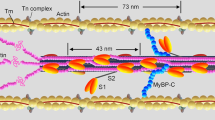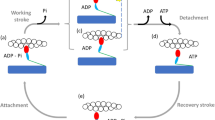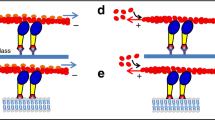Abstract
The rotating crossbridge model for muscle contraction1 proposes that force is produced by a change in angle of the crossbridge between the overlapping thick and thin filaments. Myosin, the major component of the thick filament, is comprised of two heavy chains and two pairs of light chains. Together they form two globular heads, which give rise to the crossbridge in muscle, and a coiled-coil rod, which forms the shaft of the thick filament. The isolated head fragment, subfragment-1 (S1), contains the ATPase and actin-binding activities of myosin (Fig. 1). Although S1 seems to have the requisite enzymatic activity, direct evidence that SI is sufficient to drive actin movement has been lacking. It has long been recognized that in vitro movement assays are an important approach for identifying the elements in muscle responsible for force generation2–8. Hynes et al.7 showed that beads coated with heavy meromyosin (HMM), a soluble proteolytic fragment of myosin consisting of a part of the rod and the two heads, can move on Nitella actin filaments3. Using the myosin-coated surface assay of Kron and Spudich6, Harada et al. 8 showed that single-headed myosin filaments bound to glass support movement of actin at nearly the same speed as intact myosin filaments. These studies show that the terminal portion of the rod and the two-headed nature of myosin are not required for movement. To restrict the region responsible for movement further, we have modified the myosin-coated surface assay by replacing the glass surface with a nitrocellulose film. Here we report that myosin filaments, soluble myosin, HMM or S1, when bound to a nitrocellulose film, support actin sliding movement (Fig. 2). That S1 is sufficient to cause sliding movement of actin filaments in vitro gives strong support to models of contraction that place the site of active movement in muscle within the myosin head.
This is a preview of subscription content, access via your institution
Access options
Subscribe to this journal
Receive 51 print issues and online access
$199.00 per year
only $3.90 per issue
Buy this article
- Purchase on Springer Link
- Instant access to full article PDF
Prices may be subject to local taxes which are calculated during checkout
Similar content being viewed by others
References
1. Huxley, H. E. Science 164, 1356–1366 (1969). 2. Yano, M., Yamamoto, Y. & Shimizu, H. Nature 299, 557–559 (1982). 3. Sheetz, M. P. & Spudich, J. A. Nature 303, 31–35 (1983). 4. Higashi–Fujime, S. / Cell Biol 101, 2335–2344 (1985). 5. Honda, H., Nagashima, H. & Asakura, S. /. molec. Biol. 191, 131–133 (1986). 6. Kron, S. J. & Spudich, J. A. Proc. natn. Acad. Sci. U.S.A. 83, 6272–6276 (1986). 7. Hynes, T. R., Block, S. M., White, B. T. & Spudich, J. A. Cell 48, 953–963 (1987). 8. Harada, Y., Noguchi, A., Kishino, A. & Yanagida, T. Nature 326, 805–808 (1987). 9. Okamoto, Y. & Sekine, T. J. Biochem., Tokyo 98, 1143–1145 (1985). 10. Yamamoto, K. & Sekine, T. J. Biochem., Tokyo 87, 219–226 (1980). 11. Margossian, S. S., Lowey, S. & Barshop, B. Nature 258, 163–166 (1975). 12. Yagi, K. & Otani, F. J. Biochem., Tokyo 76, 365–373 (1974). 13. Margossian, S. S., Stafford III, W. F. & Lowey, S. Biochemistry 20, 2151–2155 (1981). 14. Thomas, D. D., Seidel, J. C. & Gergely, J. J. molec. Biol. 132, 257–273 (1979). 15. Egelman, E. H., Francis, N. & DeRosier, D. J. Nature 298, 131–135 (1982). 16. Yanagida, T., Nakase, M., Nishiyama, K. & Oosawa, F. Nature 307, 58–60 (1984). 17. Mendelson, R. A., Morales, M. F. & Botts, J. Biochemistry 12, 2250–2255 (1973). 18. Thomas, D. D., Seidel, J. C., Hyde, J. S. & Gergely, J. Proc. natn. Acad. Sci. U.S.A. 72, 1729–1733 (1975). 19. Crowder, M. S. & Cooke, R. J. Muscle Res. Cell MotiL 5, 131–146 (1984). 20. Spudich, J. A. & Watt, S. /. biol Chem. 246, 4866–4871 (1971). 21. Pardee, J. D. & Spudich, J. A. Meth. Cell Biol. 24, 271–289 (1982). 22. Laemmli, U. K. Nature 227, 680–685 (1970). 23. Hanada, K. et al. Agric. biol. Chem. 42, 523–528 (1978). 24. Clarke, M. & Spudich, J. A. / molec. Biol. 86, 209–222 (1974). 25. Margossian, S. S. & Lowey, S. Meth. Enzym. 85, 55–71 (1982). 26. Gordon, D. J., Yang, Y.–Z. & Korn, E. D. /. biol. Chem. 251, 7474–7479 (1976).
Author information
Authors and Affiliations
Rights and permissions
About this article
Cite this article
Toyoshima, Y., Kron, S., McNally, E. et al. Myosin subfragment-1 is sufficient to move actin filaments in vitro. Nature 328, 536–539 (1987). https://doi.org/10.1038/328536a0
Received:
Accepted:
Issue Date:
DOI: https://doi.org/10.1038/328536a0
This article is cited by
-
Number Dependence of Microtubule Collective Transport by Kinesin and Dynein
Journal of the Indian Institute of Science (2021)
-
Single-molecule pull-out manipulation of the shaft of the rotary motor F1-ATPase
Scientific Reports (2019)
-
Direct visualization of human myosin II force generation using DNA origami-based thick filaments
Communications Biology (2019)
-
Hypertrophic cardiomyopathy and the myosin mesa: viewing an old disease in a new light
Biophysical Reviews (2018)
Comments
By submitting a comment you agree to abide by our Terms and Community Guidelines. If you find something abusive or that does not comply with our terms or guidelines please flag it as inappropriate.



